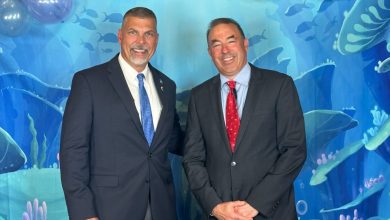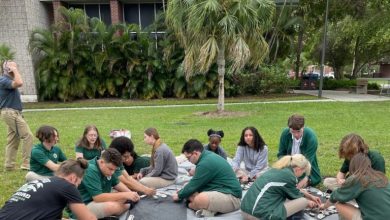Florida Tech Helps Georgia Aquarium Complete Dolphin Study in the Indian River Lagoon
Monitoring Marine Life Sentinels
Dolphins are known to marine biologists as sentinel animals, if they are ailing, we humans may be next. The Indian River Lagoon, an ecologically diverse estuary that covers 40 percent of Florida’s east coast, is ailing. The area is home to a large human population who live near its shores and plays a significant part in the area’s economy. The lagoon’s nitrogen-saturated waters—due to fertilizer run-off and other pollution—is likely promoting the algae blooms that are toxic to marine mammals and birds.
Florida Institute of Technology assistant professor Spencer Fire and researchers from lead agency Georgia Aquarium and other conservation partners recently completed a study to better understand the health of Atlantic bottlenose dolphins in the IRL, and the data collected from the dolphins is expected to help researchers understand how toxic algal blooms can harm wildlife.
 Florida Tech’s Spencer Fire examines a healthy dolphin in the Indian River Lagoon
Florida Tech’s Spencer Fire examines a healthy dolphin in the Indian River Lagoon
The research program known as HERA, or Health and Environmental Risk Assessment, examines how diseases affecting dolphins are related to potential environmental stressors and how they serve as an early warning system of changes that could affect animal and human health. Initial findings are expected in the coming weeks.
For over two weeks, a team of more than 50 specialists performed health assessments on more than 25 dolphins. The samples collected included blood, blubber and skin biopsies for genetics, as well as all the metabolic and physiological data like respiration rate, heart rate and general health parameters. Fire was specifically collecting gastric samples because of his focus on biotoxins make their way into the food web for these animals.
The biological samples collected from the dolphins will be analyzed, and the data will then be added to the HERA database.
Fire, who helped veterinarians assemble and assess the dolphins, had the rare opportunity to gather samples from healthy animals.
“The data we have for biotoxins in live marine mammals from the Indian River Lagoon are inconclusive, so this was a way to get additional data,” he said.
Fire wants to use the data as a baseline to gauge when toxin levels become fatal during an algal bloom.
Under a federal permit, HERA program researchers have safely examined and released more than 350 bottlenose dolphins, primarily from the Indian River Lagoon, since 2003. This year’s assessments were in the northern IRL, where there’ve been three unusual mortality events, or unexpected strandings in which significant numbers of dolphins died.
“Dolphins are like the proverbial canaries in a coal mine,” said Gregory Bossart, V.M.D., Ph.D., chief veterinary officer and senior vice president at Georgia Aquarium. “Understanding their health and determining what impacts them is important because they can serve as indicators of ocean health, giving insight into larger environmental issues that may also have implications for human health.”
Fire added, “If animal health is deteriorating over a trend of several years because their environment is deteriorating, what does that mean for humans? We share the same habitat, we eat a lot of the same food, we use the same waters.”
Since the internationally renowned HERA program began, it has documented emerging disease, antibiotic resistant bacteria, immune dysfunction and high levels of some toxins, including mercury in IRL dolphins.





